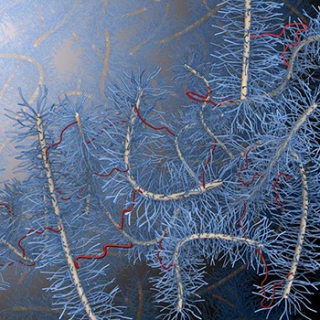Polymer chemists and physicists have developed an innovative way to produce an ultra-soft yet dry silicone rubber that has an adjustable softness to match a wide range of biological tissues. The study, which appeared on the cover of the journal Advanced Materials, holds promise in biomedical research and engineering.
 Ultra-soft elastomer fabricated by crosslinking bottlebrush polymers contains only crosslinks (red chains) and no entanglements. (Image courtesy of Li-Heng Cai)
Ultra-soft elastomer fabricated by crosslinking bottlebrush polymers contains only crosslinks (red chains) and no entanglements. (Image courtesy of Li-Heng Cai)
The research team was headed by David A. Weitz, Mallinckrodt Professor of Physics and Applied Physics at Harvard John A. Paulson School of Engineering and Applied Sciences (SEAS) and associate faculty member at the Wyss Institute for Biologically Inspired Engineering at Harvard.
Medical implants are designed to imitate the softness of human tissue by combining long silicone polymer with liquids like oil to produce a wet and squishy gel. Over the years, while such implants have enhanced significantly there is a possibility that the liquid might still leak which can prove not only painful but also dangerous.
To develop a soft elastomer, the researchers had to ensure that the entanglements are prevented right from the outset. This was achieved by fabricating a novel polymer that was not only fatter, but was also less likely to entangle than linear polymers. Dubbed as bottlebrushes, the polymers can be easily produced by using a combination of three types of linear silicone polymers that are commercially available on the market.
Conventional elastomers are intrinsically stiff because of how they are made. The network strands are very long and are entangled, similar to a bunch of Christmas lights, in which the cords are entangled and form knots. These fixed entanglements set up an intrinsic lower limit for the softness of conventional elastomers.
Li-Heng Cai, lead author and postdoctoral fellow at SEAS
The elastomers’ softness can be controlled accurately by altering the quantity of cross-linked polymers to imitate everything from relatively stiff cells to soft brain tissues. Besides controlling the softness of the elastomers, the researchers also identified a method to independently regulate the elastomer’s liquid-like behavior.
Typically the fabrication of such bottlebrush molecules requires complex chemical synthesis. But we found a very simple strategy by carefully designing the chemistry. This system creates soft elastomers as easily as silicone kits sold commercially.
Thomas E. Kodger, Ph.D.
“If there are no crosslinks, all the bottlebrush molecules are mobile and the material will flow like a viscous liquid such as honey,” said Cai. “Adding crosslinks connects the bottlebrush molecules and solidifies the liquid, increasing the material stiffness.”
“To make the conventional elastomer softer, one needs to swell it in a liquid,” said coauthor Michael Rubinstein, John P. Barker Distinguished Professor in Chemistry at the University of North Carolina at Chapel Hill. “But now we can adjust the length of ‘hairy’ polymers on the bottlebrush molecules to tune the liquid-like behavior of soft elastomers — without swelling — allowing us to make these elastomers exceptionally non-adhesive yet ultra-soft.”
These characteristics make the material suitable for both medical implants and commercial products like cosmetics.
The independent control over both softness and liquid-like behavior of the soft elastomers will also enable us to answer fundamental questions in biomedical research. For example, stem cell differentiation not only depends on the softness of materials with which they are in contact, but recent findings suggest that it is also affected by how liquid-like the materials are. This discovery will provide entirely new materials to study the cell behavior on soft substrates. The exceptional combination of softness and negligible adhesiveness will greatly broaden the application of silicon-based elastomers in both industry and research.
Weitz
Besides his role on the faculty at SEAS, Weitz also serves as the co-director of the BASF Advanced Research Initiative, director of Harvard’s Materials Research Science and Engineering Center, and a member of the Kavli Institute for Bionano Science and Technology.
Other coauthors included Adrian F. Pegoraro, a postdoctoral fellow at SEAS; and Rodrigo E. Guerra, Ph.D.’ 2015, now a postdoctoral fellow at New York University.
The Harvard Materials Research Science and Engineering Center (DMR-1420570) and the National Science Foundation (DMR-1310266) funded the study.
References